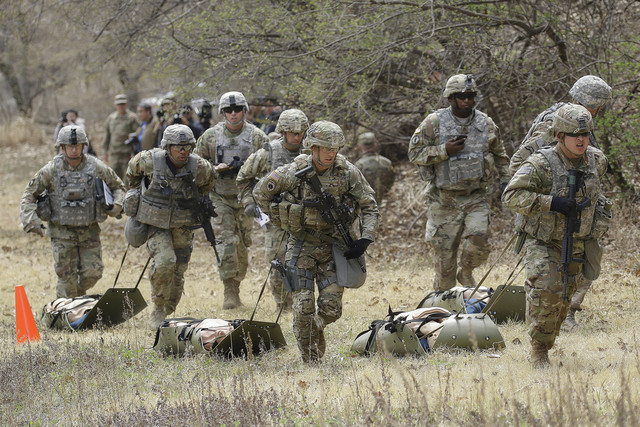By Kim Seung-yeon

SEOUL, July 31 (NNN-BERNAMA-YONHAP) — North Korea’s recent missile launches appear to be aimed at displaying discontent with next month’s joint military exercise between South Korea and the United States and strengthening its negotiating power before resuming nuclear talks with the United States, experts said Wednesday.
Wednesday’s launches of two short-range ballistic missiles off the east coast marked the second time in less than a week that the communist nation has fired missiles. Experts warn that yet more missile launches could take place until the exercise, codenamed “19-2 Dong Maeng,” is over.
“The fact that the missiles were short-range and flew at a low altitude tells us that the test-firing was directed at the South,” Nam Chang-hee, a professor at Inha University said. “The North is obviously not happy about our efforts to keep the balance of terror as we keep the military drills in place and have decided to bring in F-35 stealth fighter jets.”
North Korea has long denounced joint military drills between South Korean and U.S. forces as a rehearsal for invasion. Seoul and Washington reject the claim, arguing that such maneuvers are purely defensive in nature.
After last week’s missile firings, the North’s state media said that the launches were designed to send a “solemn” warning to South Korea over its plan to conduct joint military drills with the U.S. and purchase the high-tech fighter jets from the ally.
“It is to put pressure on Seoul since it has not changed its stance about the drills, and raise tensions by showing off its military capabilities,” Yang Moo-jin, a professor at the University of North Korean Studies, said.
Given that the missiles fired since last week flew at low altitudes of 50km and 30km, respectively, they demonstrate that the North has been improving its missile technology to an extent that they can’t be easily intercepted, experts said.
Last week’s missiles, fired on Thursday, ascended again in the final downward stage of ballistic trajectory, an advanced capability, known as a “pull-up” maneuver, which makes it difficult for interceptors to shoot down such missiles.
South Korean military officials said that Wednesday’s missiles appear to be a similar type to those launched last week that have been identified as “KN-23,” or the North’s version of Russia’s Iskander ballistic missile.
Shortly after the latest missile launches, South Korean Defense Minister Jeong Kyeong-doo said the North should be regarded as an “enemy” if it carries out provocations that threaten South Korea, an unusually strong remark coming from the defense chief of the liberal Moon Jae-in government.
Experts said that missile firings are one of the few options North Korea has to prod the administration of U.S. President Donald Trump to move the stalemated nuclear negotiations forward.
“What’s important for the North is to draw Washington’s attention and make them come up with better terms closer to their demands, and it’s their underlying message that the negotiations can break down if the U.S. doesn’t act,” Shin Beom-chul, a senior fellow at the Asan Institute for Policy Studies, said.
The nuclear talks between North Korea and the U.S. remain deadlocked after February’s Hanoi summit between Trump and North Korean leader Kim Jong-un collapsed without a deal. They failed to reach common ground on the scope of the North’s denuclearization and Washington’s sanctions relief.
Hopes for a resumption grew after Trump and Kim held a surprise meeting at the inter-Korean border on June 30 and agreed to resume working-level talks in coming weeks. Belying such optimism, however, the North conducted missile launches last week for the first time since May.
Still, Trump sought to keep up the prospect of negotiations, downplaying the launches as “smaller ones” not threatening to the U.S. and insisting that he gets along “very well” with the North leader.
Trump also said earlier Tuesday that he has a good relationship with Kim.
“My relationship with Kim Jong-un is a very good one, as I’m sure you’ve seen,” he told reporters at the White House. “We’ll see what happens. I can’t tell you what’s going to happen.”
U.S. news reports said Tuesday that a U.S. National Security Council official traveled to the Demilitarized Zone dividing the two Koreas last week and met with a North Korean counterpart to deliver photographs from the DMZ meeting between Trump and Kim.
During the meeting, the North Koreans expressed their commitment to resume talks, the reports said.
After Wednesday’s launches, the State Department only said it is aware of a missile launch.
Experts projected that Pyongyang could carry out more missile launches until the end of the joint military drills, and fresh diplomacy could follow afterwards around late August.
“Until then, the North could launch a couple more (missiles), as a way to keep its negotiating power in the dialogue process,” Shin added.
–NNN-BERNAMA-YONHAP
